
|
Battle of the Atlantic
Opening Moves
As early as November 1938, Hitler issued a directive to the German Armed forces to make preparations for a surprise attack upon Danzig, Poland. The Fuehrer further ordered that the armed forces must be ready for the operation to begin at any time from 1st September 1939, onwards.
March 1939, saw the annexation of Austria and Czechoslovakia into German territory. By August 1939, it was clear that a conflict with Poland would come sooner or later. In preparation for the attack, BdU dispatched 14 Type VII and Type IX u-boats to the Atlantic. This was followed with another 14 of the smaller Type II coastal boats, headed for the North Sea. Despite the deployment of the u-boat force, Germany did not anticipate a war with Britain. In fact, Hitler did not want a war with Britain and France – quite simply, because he wasn’t ready. The kriegsmarine was not capable of challenging the Royal Navy and the u-boat force was far too weak to undertake its mission. This was not to happen until 1948, which called for the completion of the “Z” plan - which consisted of the creation of a powerful sea fleet capable of challenging British superiority.
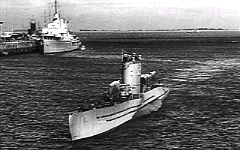
|
| U-29, a Type VII was the first u-boat to engage the Royal Navy. She sank the British carrier HMS Courageous during this engagement. Sept 1939. |
Nonetheless, within six weeks, the unthinkable happened – Germany was at war with Britain and France. When news of the war first broke to Donitz, he was heard to exclaim, “My God! So it’s war with England again!” Donitz had only 57 boats out of the 300 he wanted. Of these, only 38 were capable of operations in the Atlantic. About one-third would be refitting and resupplying in port, one-third on their way to or back from their patrol zones. This meant that at any one time, there were less than a dozen boats operating in their given patrol zones. With such a small presence, it would clearly be difficult to make much of an impact on Britain’s shipping. The British and French had more than ten times as many warships. The u-boat force saw the situation as a “desperate one”. But they were highly motivated and supremely trained and supremely confident in their equipment and their leader. And most of all, they had a job to do, for which they were prepared to at least try.
Despite the small numbers, the u-boat force achieved immediate and remarkable success within the first month of the war itself. On September 17 1939, U-29 a Type VII u-boat commanded by Kapitänleutnant Otto Schuhart spotted a 22,500 ton aircraft carrier HMS Courageous on anti submarine patrol about 200 miles southwest of Ireland. It was an accident that Schuhart spotted the carrier at all, as he was actually searching for a convoy suspected to be in the area. Fortunately for U-29, two out of four of the carrier’s destroyer escort were dispatched to assist a merchant ship. Schuhart slipped past the remaining escorts and fired a spread of three torpedoes from a distance of less than 3000 yards. Two hit the target, sinking the proud carrier in 17 minutes with the loss of 518 lives. The HMS Courageous was the first Royal Navy warship sunk, and more importantly, the British Admiralty withdrew all carriers from the western approaches. The first naval engagement between u-boats and the Royal Navy turned out to be a resounding German victory. Carriers were not to be seen in those waters for another four years.
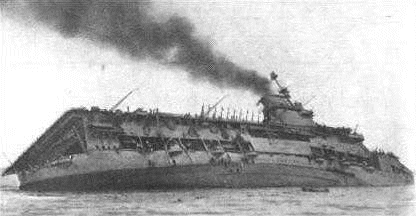
|
| September 17 1939, HMS Courageous torpedoed by U-29, The first Royal Navy ship sunk during WW2. |
By the end of the first month, the allies lost 41 merchant ships totaling over 150,000 tons, and 1 aircraft carrier. The Germans lost 2 u-boats.
An even more resounding victory soon followed. Scapa Flow, a highly defended port off the northern coast of Scotland served as the main anchorage for British warships. Admiral Donitz had long wanted to penetrate the defenses and sink the capital warships which were sure to be anchored there. On September 26th, the Luftwaffe managed to obtain excellent aerial photography of the port defenses. It had a narrow entrance, which was shallow with strong raging current. The narrow harbor entrance is further blocked with sunken blockships to prevent any u-boat penetration. Any approaches had to be done from the surface, at night under the cover of darkness – where the u-boat’s low silhouette would make detection difficult.
The skipper Donitz selected for this mission was Gunther Prien, Korvettenkapitan of U-47, a Type VIIB u-boat. Gunther Prien had sunk three ships on his first war patrol, totalling over 66,000 tons and had won the Iron Cross, Second Class. He studied the plans overnight and confidently accepted the mission.
On October 8, U-47 departed Kiel and headed for Scapa Flow. The aircraft carrier HMS Furious, battleships Rodney, Nelson and Royal Oak, and heavy cruiser Hood and Repulse were in anchor at Scapa Flow. However they had set sail by October 13 due to precautionary measures of a Luftwaffe air raid after a reconnaissance plane was spotted flying at low altitude just a few days earlier. Part of the fleet was also dispatched to hunt the German heavy cruiser Gneisenau in the North Sea. The Royal Oak stayed behind and remained at anchor to provide air defense.
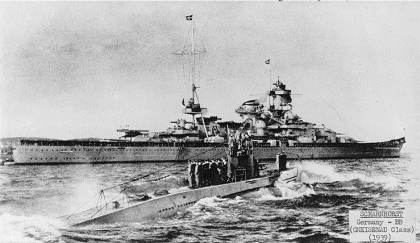
|
| October 14 1939, the day when everything seemed possible. U-47 receiving a salute from battleship Scharnhorst after returning from Scapa Flow. |
Late in the evening of October 13, U-47 begins to work its way through the British defenses and moved into the narrow harbor entrance. As the approach was done on the surface, at night with no moon, the u-boat was so close to the shore that at one point, the conning tower of the u–boat was illuminated by the headlights of a passing car – which turned around and abruptly raced away. The crew could see vehicles and sentry guards on the shoreline just a few dozen meters away.
Just after midnight on October 14, U-47 was inside Scapa Flow. Prien did a quick search and spotted two large ships. He fired a salvo of three torpedoes at the overlapping targets and after a run of three and a half minutes, a small explosion was heard. The other two torpedoes had either missed or misfired – a common flaw with early torpedoes. The first explosion seemed to have attract no attention. Being in the harbor of Scapa Flow, the furthest thought on their mind was a torpedo attack. Quickly reloading his tubes, Prien turned back for a second attack. Firing another three torpedoes from the bow and one from the stern, three explosions ripped through the hull of the Royal Oak.- sinking her in 10 minutes with the loss of 833 lives. U-47 slipped away undetected and returned to Germany to a hero’s welcome. This was the most famous u-boat exploit of the war which scored the Germans a major propaganda victory, immediately turning Gunther Prien into a national hero.
Donitz was promoted to Rear Admiral, the entire crew was awarded the Iron Cross Second Class, Prien himself the Iron Cross First Class and later the Knights Cross was pinned personally on his breast by Adolf Hitler.
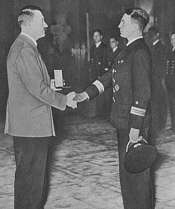
|
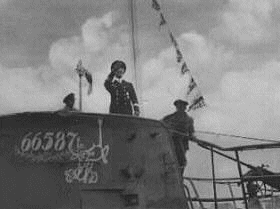
|
| Hitler personally decorates Prien for the Scapa Flow operation. | The Bull of Scapa Flow. U-47's insignia of a snorting bull can barely be made out on the conning tower. |
This attack left a dent in the Royal Navy pride. It became evident at this point to the British Admiralty that they had underestimated the u-boat threat. It was just after two months into the war, and if sinkings continued at this rate, the Royal Navy would soon be defeated along with her merchant ships and Britain’s ability to continue fighting. To counter the u-boat threat, the British Admiralty implemented three main strategies.
The first was the blockading of the English Channel with mine barrages. These mining operations did not sink many u-boats, but three u-boats were sunk as a result of mines off the Straits of Dover. Thereafter u-boats avoided the English Channel and were forced to circle all the way around the British Isles to reach their patrol zones in the North Atlantic.
The second was the formation of hunter groups. Here the British made a serious tactical mistake. This called for the deployment of anti-submarine vessels into an organized task force to hunt and destroy u-boats. Although sounding good in theory and satisfying the psychological need to take on the offensive – in practice all this had achieved was the deployment of destroyers into the empty oceans of the Atlantic - where u-boats were not to be found. They were to be found closer to home waters, stalking and attacking their prey around convoys. This mistake was only to be repeated by the Americans a few years later. Nonetheless, hunter groups accounted for three u-boat sinkings during the first phase of the war.
The third was the use of aircraft in an anti-submarine role. Again through the lack of anti-submarine research and development between the wars, Britain was left with no effective anti-submarine aircraft, weapons or equipment. For example, the lack of detection gear meant that aircraft relied on visual lookouts to spot their targets. U-boats with their low silhouette made visible sighting very difficult. Any encounter was by chance and even then, the depth setting for airborne charges were set to detonate at 20 meters – far too deep to catch a surprised u-boat just beginning its dive. This simple error caused many well conducted surprise attacks to be less than totally effective. Furthermore, the lack of effective underwater detection gear meant that depth charges will have little chance of hitting its target at below 150 meters. It would not be until 1942, before the allies had any effective anti-submarine weapons and equipment to have a decisive effect on the u-boats.
The Germans too suffered from faulty equipment. Countless allied ships escaped because of faulty torpedoes which either ran too deep, slammed harmlessly into the hulls, or exploded prematurely before reaching its target. On September 14th 1939, U-39 had slipped past the destroyer escort screens of HMS Ark Royal and successfully launched two torpedoes at the British carrier. These torpedoes used magnetic detonators – which exploded prematurely in the carrier’s wake. These explosions alerted the escorting destroyers Faulknor, Firedrake and Foxhound, which subsequently depth charged and sunk U-39 – the first u-boat lost during the war. In March of 1940, Donitz was ordered to send all available u-boats in support of the invasion of Norway. Here again, the campaign turned into a major scandal as u-boats were presented with many targets, only to be hampered by faulty torpedoes. It was not until the December of 1942 that the problem of faulty detonators was solved.
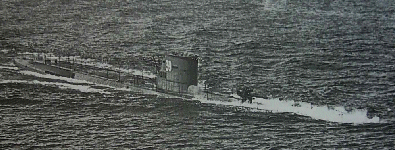
|
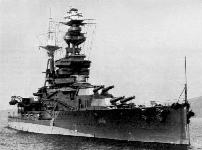
|
| U-39, a Type IXA, the first u-boat sunk during WW2 after a failed attack on HMS Ark Royal. | British battleship HMS Royal Oak. |
Meanwhile, the German and British Naval Intelligence code intercepting service were busy deciphering each other’s radio messages. The German code breaking service B-Dienst had the early advantage when they had broken the British Admiralty code and were able to provide excellent information on the routes and departure dates of the convoys – and sometimes the locations of hunter groups as well. Until August of 1940, when the British Navy switched codes, the Germans were reading a steady flow of traffic which supplied BdU with precise intelligence for coordinating and planning u-boat attacks.
Shortly after war began, as the u-boat arm proved a formidable foe to allied shipping, the pre-war construction plan for a strong German fleet (“Z” plan) was scrapped with emphasis placed on u-boat construction. Donitz was promised 25 new boats a month – a figure he felt was much lower than was needed for decisive attacks on the convoy system. Considering the time required to train new crew, construct new boats and the inevitable u-boat losses at sea, Donitz would continue to be faced with a crippling shortage of u-boats throughout the first phase of the Battle of the Atlantic. In fact, the lowest point of the u-boat shortage occurred in February 1941, when only 22 u-boats were capable of putting to sea. Thereafter the numbers rose slowly but it was not until the middle of 1943 that the number of u-boats reached a number sufficient enough for decisive attacks on the convoy system.
In the political arena, u-boats were required to operate under the pre-war maritime Prize Rules, the international agreements which governed the conduct of war at sea. Merchant ships had to be stopped and searched before they could be sunk - but only after the crew had been safely evacuated on lifeboats. The u-boat commanders viewed this as an unnecessary threat to the attacking boats and were eager to move toward unrestricted submarine warfare. By September 23rd, u-boats were allowed to sink immediately any merchant using its radio after being stopped by a u-boat. October 2nd saw the lifting of restrictions of attacking darkened ships off the British and French coasts. By October 17, u-boats were allowed to attack all hostile ships and by November 17, to attack all ships including passenger liners. The only restriction governing u-boats was that they were not allowed to attack neutral vessels.
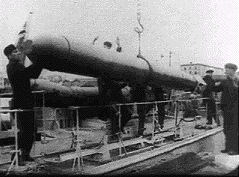
|
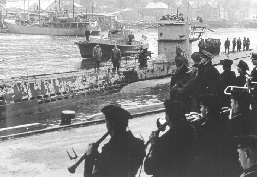
|
| German sailors loading a torpedo. Depending on crew fatigue and experience, it takes between 15 to 30 minutes to reload a tube. | A u-boat's welcome after a successful Norwegian campaign. Note the band welcoming her home. |



